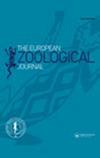Population ecology of Gibbula umbilicaris and Gibbula ardens (Gastropoda: Trochidae) in a Posidonia oceanica seagrass bed
引用次数: 4
Abstract
Abstract Population structures of the gastropods Gibbula umbilicaris and Gibbula ardens (Trochidae), the two most common species of the genus Gibbula living in shallow beds of the Mediterranean seagrass Posidonia oceanica, were investigated in the seagrass bed off Lacco Ameno of Ischia (Gulf of Naples), at six stations along a depth gradient (1, 3, 5, 10, 15 and 25 m). Sampling was performed on a monthly basis for 1 year. A total of 853 individuals were counted and measured. The two gastropod populations analysed show a rather similar distributional trend in all seasons and depths. Recruitment occurred at the shallowest stations (1–3 m depth), where the populations were characterised by higher values of abundance and biomass, confirming that G. umbilicaris and G. ardens are typical species of the shallow community of P. oceanica seagrass beds. Juveniles were exclusively found in 1 month of the whole year: G. umbilicaris in April, G. ardens in July. The survivorship curves of both Gibbula species, derived from the size-frequency distribution of shells, showed a very low mortality rate in the first months after settlement. Demographic analysis of G. umbilicaris suggests a rather slow growth rate and a polymorphic maturation strategy with a lifespan of 1 year for most individuals, but lifespan may also reach about 2 years in a few specimens. Gibbula ardens has a lifespan of about 1 year and a fast growth rate, especially during the first couple of months after settlement. Therefore, on the basis of lifespan and recruitment time, both species seem to be semelparous.海洋波西多海草床中脐带赤臂猿和花园赤臂猿的种群生态学
摘要/ Abstract摘要:本文在意大利那不勒斯湾(Ischia) Lacco Ameno海域沿深度梯度(1、3、5、10、15和25 m)的6个站点,对生活在地中海海草Posidonia oceanica浅层中最常见的腹足类长臂虫(Gibbula umbilicaris)和麻足长臂虫(Gibbula ardens, Trochidae)的种群结构进行了调查,取样时间为1年,每月一次。共对853人进行了统计和测量。所分析的两个腹足类种群在所有季节和深度都显示出相当相似的分布趋势。招募发生在最浅的站点(1-3 m深度),那里的种群具有较高的丰度和生物量,证实了G. umbilicaris和G. ardens是P. oceanica海草床浅层群落的典型物种。全年只在1个月发现幼虫:4月发现脐带小蠹,7月发现花坛小蠹。根据贝壳的大小-频率分布得出的两种长臂猿的生存曲线显示,在定居后的头几个月死亡率非常低。人口统计学分析表明,脐带鱼的生长速度较慢,大多数个体的寿命为1年,但也有少数标本的寿命可达2年左右。长臂猿的寿命约为1年,生长速度快,特别是在定居后的头几个月。因此,从寿命和招募时间来看,这两个物种似乎都是半胞胎。
本文章由计算机程序翻译,如有差异,请以英文原文为准。
求助全文
约1分钟内获得全文
求助全文

 求助内容:
求助内容: 应助结果提醒方式:
应助结果提醒方式:


